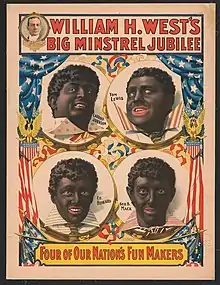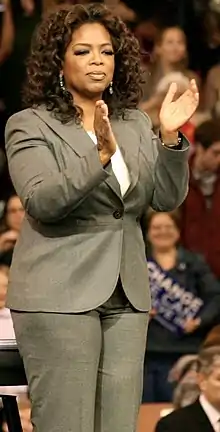Racist rhetoric is distributed through computer-mediated means and includes some or all of the following characteristics: ideas of racial uniqueness, racist attitudes towards specific social categories, racist stereotypes, hate-speech, nationalism and common destiny, racial supremacy, superiority and separation, conceptions of racial otherness, and anti-establishment world-view.[1][2][3][4][5] Racism online can have the same effects as offensive remarks made face-to-face.[6]
Definitions
The term "cyber racism" was coined by English sociologist Les Back in 2002.[7] Cyber racism has been interpreted to be more than a phenomenon featuring racist acts displayed online. According to the Australian Human Rights Commission, Cyber-Racism involves online activity that can include "jokes or comments that cause offense or hurt; name-calling or verbal abuse; harassment or intimidation, or public commentary that inflames hostility towards certain groups".[8]
Roots and enabling factors
Institutional racism
Though there have been studies and strategies for thwarting and confronting cyber racism on the individual level there have not been many studies that expand on how cyber racism's roots in institutional racism can be combated.[9] An increase in literature on cyber racism's relationship with institutional racism will provide new avenues for research on combatting cyber racism on a systemic level.[10] For example, cyber racism's connections to institutional racism have been noted in the work of Jessie Daniels, a professor of sociology at Hunter College.[11]
Although some tech companies have taken steps to combat cyber racism on their sites, most tech companies are hesitant to take action over fears of limiting free speech.[12] A Declaration of the Independence of Cyberspace, a document that declares the internet as a place free from control by "governments of the industrial world",[13] continues to influence and reflect the views of Silicon Valley.
Online stereotypes
Online stereotypes can cause racist prejudice and lead to cyber racism. For example, scientists and activists have warned that the use of the stereotype "Nigerian Prince" for referring to advance-fee scammers is racist, i.e. "reducing Nigeria to a nation of scammers and fraudulent princes, as some people still do online, is a stereotype that needs to be called out".[14]
Black-fishing & Profiting From Black Aesthetics
According to CNN, the definition of Blackfishing occurs when a non-Black celebrity or influencer, intentionally alter their physical appearance, by appropriating the skin tone, hair texture and overall aesthetics associated with and/or originating from Black people. It is extremely common on social media. Many non-Black celebrities have been criticized over tanning their skin to appear darker skinned, often times looking more racially ambiguous and/or Black. It is believed that the increase of Social Media Marketing, has made space for more contemporary racist microaggressions that involve the monetization of aesthetics associated with Black American culture.
Digital Blackface


Blackface, the stereotypical practice of caricaturing Black people, has been around since the 19th century. The theatrical minstrel show included White performers participating "comedic", though highly racist, skits, and performances depicting Black people. Performers would often paint their faces black with obnoxiously big red lips as well as talk in early African American Vernacular English to symbolize their perceptions of Black people.[15] The stereotypes portrayed in minstrel shows have been reflected in various forms of media over time such as Hattie McDaniel's role as the motherly, yet desexualized "mammy" in the 1939 film adaptation of the novel Gone with the Wind,[16] or the lazy and inarticulate "coon" caricature.[17] Today, the advancement of technology has allocated the use of GIFs and reaction memes of Black people to portray exaggerated forms emotions online because internet users think of Black people as "excessively expressive and emotional". One of the most commonly used people in GIFs and memes is media mogul Oprah Winfrey, who's clips from her former talk show and occasional TV specials are often created into gifs and memes and are used frequently on the internet.[18]
Online anonymity
Racist views are common and often more extreme on the Internet due to a level of anonymity offered by the Internet.[19][20] In a 2009 book about "common misconceptions about white supremacy online, [its] threats to today's youth; and possible solutions on navigating through the Internet, a large space where so much information is easily accessible (including hate-speech and other offensive content)", City University of New York associate professor Jessie Daniels claimed that the number of white supremacy sites online was then rising; especially in the United States after the 2008 presidential elections.[21]
Online alt-right communities
The popularity of sites used by alt-right communities has allowed cyber racism to garner attention from mainstream media. For instance, the alt-right claimed the "Pepe the frog" meme as a hate symbol after mixing "Pepe in with Nazi propaganda" on 4chan.[12][22] This gained major attention on Twitter after a journalist tweeted about the association. Alt-right users considered this a "victory" because it caused the public to discuss their ideology.
Algorithmic bias
In her article "Rise of the Alt-Right",[12] Daniels explains how algorithms "speed up the spread of White supremacist ideology" by producing search results that reinforce cyber racism.[12] Daniels posits that algorithms direct alt-right users to sites that echo their views. This allows users to connect and build communities on platforms that place little to no restrictions on speech, such as 4chan. Daniels points to the internet searches of Dylann Roof, a white supremacist, as an example of how algorithms perpetuate cyber racism. She claims that his internet search for "black on white crime" directed him to racist sites that reinforced and strengthened his racist views.[12] Moreover, Latanya Sweeney, a Harvard professor, has found that online advertisements generated by algorithms tend to display more advertisements for arrest records with African American-sounding names than Caucasian-sounding names.
Discriminatory design
Daniels writes in her 2009 book Cyber Racism that "white supremacy has entered the digital era" further confronting the idea of technology's "inherently democratizing" nature.[10] Yet, according to Ruha Benjamin, researchers have concentrated on cyber racism's focus on "how the Internet perpetuates or mediates racial prejudice at the individual level rather than analyze how racism shapes infrastructure and design."[10] Benjamin continues by stating the importance of investigating "how algorithms perpetuate or disrupt racism…in any study of discriminatory design."[10]
Laws
Australia
In Australia, cyber-racism is unlawful under S 18C of the Racial Discrimination Act 1975 (Cth). As it involves a misuse of telecommunications equipment, it may also be criminal under S 474.17 of the Criminal Code Act 1995 (Cth).[23] State laws in each Australian State make racial vilification unlawful, and in most states serious racial vilification is a criminal offense. These laws also generally apply to cyber-racism, for example S 7 "Racial vilification unlawful" and S 24 "Offense of serious racial vilification" of the Racial and Religious Tolerance Act 2001 (Vic) both explicitly state that the conduct being referred to may include the use of the Internet.[24]
Legal cases
Yahoo! case
In May 2000, after the League Against Racism and Anti-Semitism (la Ligue Internationale Contre le Racisme et I'Antisemitisme-LICRA) and the Union of French Jewish Students (UEJF) brought an action against Yahoo! Inc., which hosted an auction website to sell Nazi paraphernalia, a French judge ruled that Yahoo should stop providing access to French users.[25]
See also
References
- ↑ Cheng, Yinghong (2011). "From Campus Racism to Cyber Racism: Discourse of Race and Chinese Nationalism". The China Quarterly. 207 (207): 561–579. doi:10.1017/S0305741011000658. JSTOR 41305257. S2CID 145272730.
- ↑ Daniels, Jessie, 1961- (2009). Cyber racism : white supremacy online and the new attack on civil rights. Lanham, Md.: Rowman & Littlefield Publishers. ISBN 978-0-7425-6525-8. OCLC 403819711.
{{cite book}}: CS1 maint: multiple names: authors list (link) CS1 maint: numeric names: authors list (link) - ↑ Jakubowicz, Andrew; Dunn, Kevin M.; Mason, Gail; Paradies, Yin; Bliuc, Ana-Maria; Bahfen, Nasya; Oboler, Andre; Atie, Rosalie; Connelly, Karen (2017). Cyber Racism and Community Resilience: Strategies for Combating Online Race Hate. ISBN 978-3-319-64387-8.
- ↑ Back, Les (2002-01-01). "Aryans reading Adorno: cyber-culture and twenty-firstcentury racism". Ethnic and Racial Studies. 25 (4): 628–651. doi:10.1080/01419870220136664. S2CID 145092638.
- ↑ Daniels, Jessie (2009-08-01). "Cloaked websites: propaganda, cyber-racism and epistemology in the digital era". New Media & Society. 11 (5): 659–683. doi:10.1177/1461444809105345. S2CID 206726655.
- ↑ "Racism. No Way: Cyber Racism". NSW Government, Education and Communities. 2013. Archived from the original on 19 February 2017. Retrieved 16 April 2014.
- ↑ Back, Les (2002). "Aryans reading Adorno: cyber-culture and twenty-firstcentury racism". Ethnic and Racial Studies. 25 (4): 628–651. doi:10.1080/01419870220136664. S2CID 145092638.
- ↑ "What is Cyber-Racism". Australian Human Rights Commission. 2014. Archived from the original on 14 July 2014. Retrieved 7 June 2014.
- ↑ Jakubowicz, Andrew (2017-11-12). Cyber Racism and Community Resilience : Strategies for Combating Online Race Hate. ISBN 9783319643885. OCLC 1026787955.
- 1 2 3 4 Benjamin, Ruha (2019-08-05). Race after technology : abolitionist tools for the new Jim code. Cambridge, UK. ISBN 9781509526390. OCLC 1078415817.
{{cite book}}: CS1 maint: location missing publisher (link) - ↑ Benjamin, Ruha. (2019). Race after Technology : Abolitionist Tools for the New Jim Code. Polity Press. ISBN 9781509526406. OCLC 1115007314.
- 1 2 3 4 5 Daniels, Jessie (February 2018). ""The Algorithmic Rise of the "Alt-Right"". Contexts. 17: 60–65. doi:10.1177/1536504218766547 – via SAGE Publications.
- ↑ Barlow, John Perry (January 20, 2016). "A Declaration of the Independence of Cyberspace". Electronic Frontier Foundation.
- ↑ Yékú, James (2020-05-03). "Anti-Afropolitan ethics and the performative politics of online scambaiting". Social Dynamics. 46 (2): 240–258. doi:10.1080/02533952.2020.1813943. S2CID 222232833.
- ↑ Matamoros-Fernandez, Ariadna (2020-01-06). "'El Negro de WhatsApp' meme, digital blackface, and racism on social media". First Monday. 25 (1). ISSN 1396-0466.
- ↑ "The Mammy Caricature - Anti-black Imagery - Jim Crow Museum". www.ferris.edu. Retrieved 2022-12-10.
- ↑ "The Coon Caricature - Anti-black Imagery - Jim Crow Museum". www.ferris.edu. Retrieved 2022-12-10.
- ↑ Erinn, Wong (2019-04-01). "Digital Blackface: How 21st Century Internet Language Reinforces Racism".
{{cite journal}}: Cite journal requires|journal=(help) - ↑ Manfred, Tony (24 May 2012). "Why Is The Internet So Racist?". Business Insider. Retrieved 2 July 2013.
- ↑ Younge, Gary (12 July 2012). "Who thinks about the consequences of online racism?". The Guardian. Retrieved 2 July 2013.
- ↑ "Cyber Racism: Race and Technology". WordPress.com. 2013. Retrieved 16 April 2014.
- ↑ Nuzzi, Olivia (2016-05-26). "How Pepe the Frog Became a Nazi Trump Supporter and Alt-Right Symbol". Retrieved 2019-11-18.
- ↑ "OHPI Submission on Racial Discrimination and S 18C". Online Hate Prevention Institute. 2014. Retrieved 7 June 2014.
- ↑ "Racial and Religious Tolerance Act 2001 (Vic) Sect 24". AUSTLII. 2013. Retrieved 7 June 2014.
- ↑ "France bans internet Nazi auctions". BBC News. 2000. Retrieved 8 May 2014.